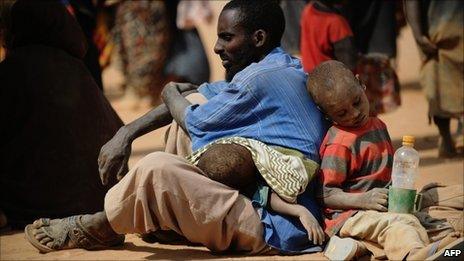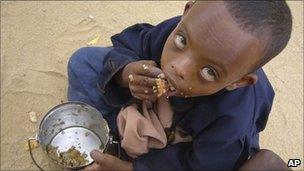Horn of Africa drought: 'A vision of hell'
- Published

The UK's Disasters Emergency Committee (DEC) has launched an emergency appeal to help the more than 10 million people affected by severe drought in the Horn of Africa. The BBC's Ben Brown reports from the Dadaab refugee camp in eastern Kenya, where more than 1,000 people arrive each day seeking help.
At a makeshift cattle market in the middle of the refugee camp, herdsmen are trying to sell off what little livestock they have left.
But no-one wants to buy the cattle and goats on sale here, for the chances are that very soon they will be dead.
There is nowhere for them to graze: the pastures here are parched and arid, and it has barely rained for two years running.
"I'm selling my cattle at knock-down prices," said one man. "I'm practically giving them away."
Not far away, the landscape is littered with the carcasses of dead animals.
In this part of the world, livestock are everything: they represent a family's entire assets, capital, savings and income. When the animals die, it frequently means the humans do as well.
Across the sprawling mass of the Dadaab refugee camp - some 50 km sq (19 sq miles) - there are several graveyards now, full of small mounds of earth, where chronically malnourished Somali refugees have been buried.
Usually the graves are horribly small: infant mortality in this camp has risen threefold in the last few months, according to the United Nations.
Infants - children aged five and under - are especially vulnerable to malnutrition and all the illnesses and diseases which frequently accompany it, such as pneumonia and diarrhoea.
With more than 1,000 refugees arriving here every day, Dadaab is becoming overcrowded and insanitary. The camp director told me there could soon be half a million people here - more a city than a refugee camp.
Many of the new arrivals have walked for days or weeks to get here, desperate to escape not only from the drought in Somalia but also its endless civil war.
The children especially are malnourished and dehydrated when they finally get here. The tragic irony is that some of them will die within a day or so of their arrival.
Crisis frontline
Katharina Andrey, a Swiss nurse from the medical aid agency Medecins Sans Frontieres (MSF), has the job of helping to prioritise which children need the most help the quickest.
Babies are measured and weighed - often they yelp and scream as they are placed into a large black plastic bucket so that their weight can be read.
Sometimes babies of six months or a year weigh little more than newborns.
Ms Andrey is on the frontline of this unfolding crisis - one woman surrounded by a sea of faces, working frantically to save lives, while winds whip up dust clouds around her and babies scream and vomit.
"I arrived here a few days ago and my first reaction was: 'Oh my God'," she told me.

Some mothers are letting the weakest children die, while they try to save the stronger ones
Ms Andrey rushes around, handing out high-energy biscuits and checking which babies need to be taken to one of the camp's clinics.
Recently, a child she was trying to save didn't make it and she grieved alongside the mother.
"The baby was dying. I tried to do something but it just died in my arms and that is really hard to cope with, I just cried with the mother. It may be hard to go back to work but it can be a motivation as well because I am here to improve things. "
But sometimes, Ms Andrey has to persuade mothers to go with their severely malnourished children to hospital.
'World doesn't listen'
Frequently, they do not want to go - they say they need to forage for food, water and firewood for their other children - often as many as seven or eight - and they cannot afford to be away from their families.
To some mothers, the weak, malnourished child has become a burden and they are prepared to let it die - a sacrifice in order to save their other children.
Aid workers like Abubakar have to negotiate hard with mothers to convince them to change their minds.
"Some families had already prepared children for death and we had to intervene and tell them: 'No, this is not possible, this child is still alive and he can make it, so you have to give us a chance to try.' So we have to negotiate with them. It's hard but sometimes we win."
The place to which he wants to take the most seriously ill children is MSF's intensive therapeutic feeding centre.
Inside, it is a vision of hell.
Tiny, emaciated children with wrinkled skin hanging off their bones, rib cages jutting out, bulbous eyes gazing out forlornly, flies covering their faces - the all-too-familiar images of African hunger.
"Some of them die on the way, some die in the wards," said Dr Christopher Karisa. "What we are doing here can seem like a drop in the ocean but the ocean will be a drop less if we don't do it. It's a challenge, a really big challenge."
But how could this be happening again, in July 2011?
One aid worker told me: "We were supposed to have an early warning system but what is the point of warning the rest of world when it doesn't listen?".